The Manifesto presents a number of claims about the current teaching practices of music theory and aural skills faculty across the country. In pursuit of a greater understanding of the current pedagogical practices in music theory as reflected by current research in music theory pedagogy, I have compiled a bibliography of articles published since the beginning of 2010 in all music theory journals (plus the College Music Symposium) that focus on integration, diversity, or creativity, as they are defined in the Manifesto. I have also included essay collections and selected textbooks that address the implementation of one or more of these pillars into the music theory classroom. The bibliography is found at the conclusion of the article as an appendix.
Integration
I will begin with integration, which is defined in the Manifesto as the instructional synthesis of keyboard skills, aural skills, and music theory, as well as (to a lesser extent) performance and music history. Integrative thinking can be witnessed by perusing music theory textbooks published since 2000, many of which encourage the instructor to assimilate these concepts in more than a cursory fashion, particularly when it comes to aural skills, keyboard skills, and written theory. Notable in this regard is The Musician's Guide to Aural Skills, by Joel Phillips, Paul Murphy, Elizabeth West Marvin, and Jane Piper Clendinning, a text focusing on contextual listening activities that require the application of written theory knowledge, and also includes a separate section dedicated to keyboard skills to accompany each chapter.1 Example 1 presents a typical illustration: a keyboard exercise on tonic and dominant functions, which also encourages students to understand the idiomatic voice leading therein by singing the four parts as a single melodic line, which is shown at the bottom of the page. This task clearly expects students to play the keyboard and sing—and, to not only apply written theory knowledge to their aural and keyboard skills, but also to use their aural and keyboard skills to hone their written theory knowledge. Similar material is provided for every chapter.
Example 1. Joel Phillips, Paul Murphy, Elizabeth West Marvin, Jane Clendinning, The Musician's Guide to Aural Skills, 2nd ed. (2011), p. 416

Similarly, the musicianship workbook accompanying Steve Laitz's The Complete Musician includes not only singing and keyboard exercises, but also a wide variety of sing-and-play exercises that encourage the integration of written theory knowledge.2 Example 2 provides a typical example, in which the student is expected not only to sing the melody, but also to provide roman numerals and realize each of three possible figured basses at the keyboard while they sing. As a summative step, students are then asked to combine their favorite elements from each figured bass.
Example 2. Steven G. Laitz, Skills and Musicianship Workbook to Accompany The Complete Musician, 3rd ed. (2012), p. 252 (Example used by permission of Oxford University Press, USA)

Finally, Michael Rogers's well-known book Teaching Approaches in Music Theory, first published in 1984, spends much of the second chapter examining the benefits and challenges inherent in the execution of a combined theory and aural skills curriculum; in the introduction, Rogers offers a quote that perfectly summarizes my view and the view of many of my colleagues: "Like a drop of ink in a glass of water, music theory should infuse and permeate all aspects of a college music curriculum."3
Such integrative topics also figure prominently in music theory pedagogy research. Examples include Michael Callahan's article on the integration of keyboard skills with written theory in the latest volume of Music Theory Online;4 relevant as well is the integration of performance and analysis advocated by Samuel Ng's 2014 article in the Journal of Music Theory Pedagogy, which details a methodology for using recorded performances as text in an analysis class.5 Keith Salley also advocates for topical integration in his 2011 essay on incorporating formal analysis into the aural skills classroom through the use of popular music.6
Diversity
The Manifesto defines diversity as the inclusion of repertoire from outside the Western concert music tradition: jazz, musical theater, and popular music. Nearly all music theory textbooks now include examples of music from a variety of styles and genres, though the depth and selection vary widely. Particularly germane to this discussion is Jennifer Snodgrass's text for music industry majors, Contemporary Musicianship: Analysis and the Artist.7 Example 3 provides two pages from Chapter 6, which covers seventh chords. The first excerpt originates from a film score by Ennio Morricone, and the other originates from a song by Bruno Mars. The same chapter features examples by Debussy, Gershwin, Rachmaninoff, and Rodgers and Hart. Such variety is typical throughout the text.
Example 3. Jennifer Snodgrass, Contemporary Musicianship: Analysis and the Artist (2015), pp. 118 and 125 (Examples used by permission of Oxford University Press, USA)
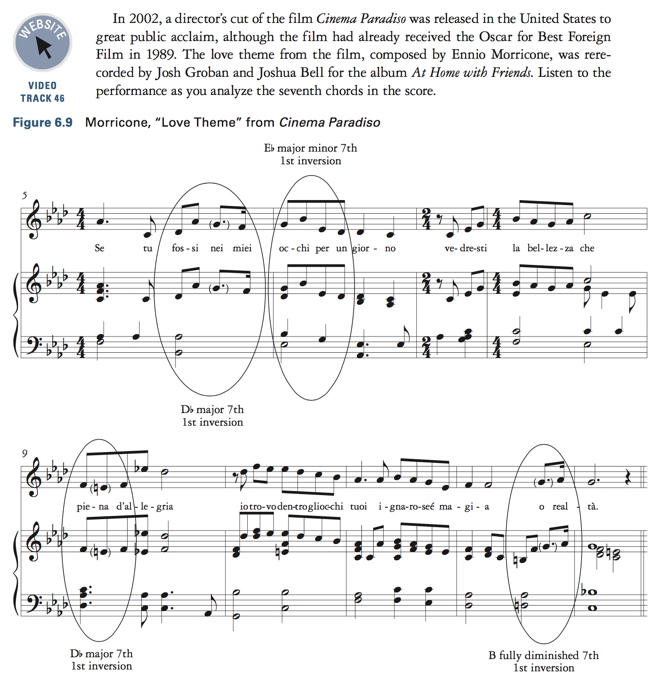
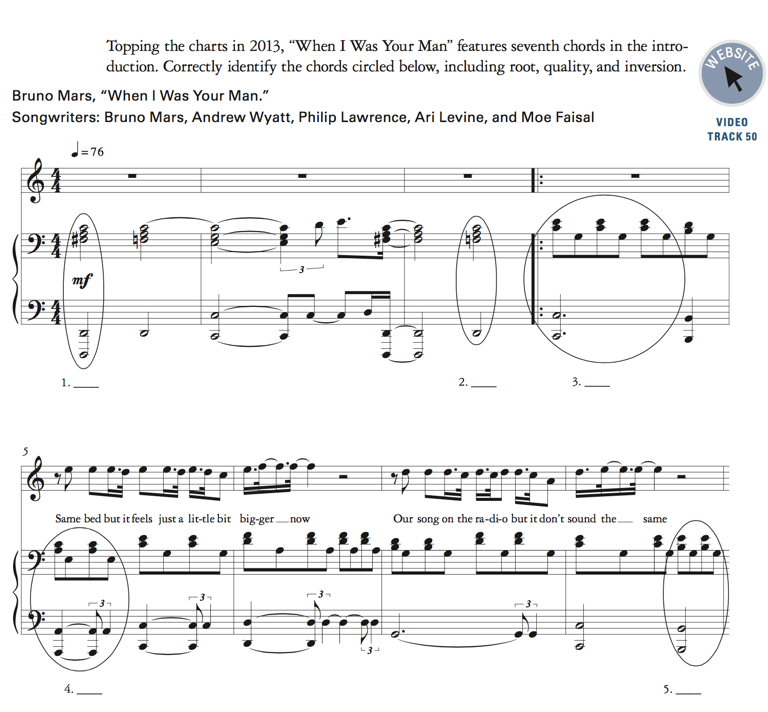
Another text that stands out with regard to diversity is Evan Jones, Matthew Shaftel, and Juan Chattah's text Aural Skills in Context, which not only features contextual listening exercises and sight-singing melodies from such diverse artists as Freddie Mercury, Michael Jackson, and Cee Lo Green, among many others, but also asks students to improvise in a variety of styles, often in a jazz or popular idiom, with accompanying tracks provided online.8 Example 4 offers a glimpse of the sorts of activities one typically finds within this text: a contextual listening exercise on Ritchie Valens's "La Bamba," and the Beatles' "Twist and Shout."
Example 4. Matthew R. Shaftel and Evan Jones with Juan Chattah, Aural Skills in Context: A Comprehensive Approach to Sight Singing, Ear Training, Keyboard Harmony, and Improvisation (2013), p. 125 (Example used by permission of Oxford University Press, USA)
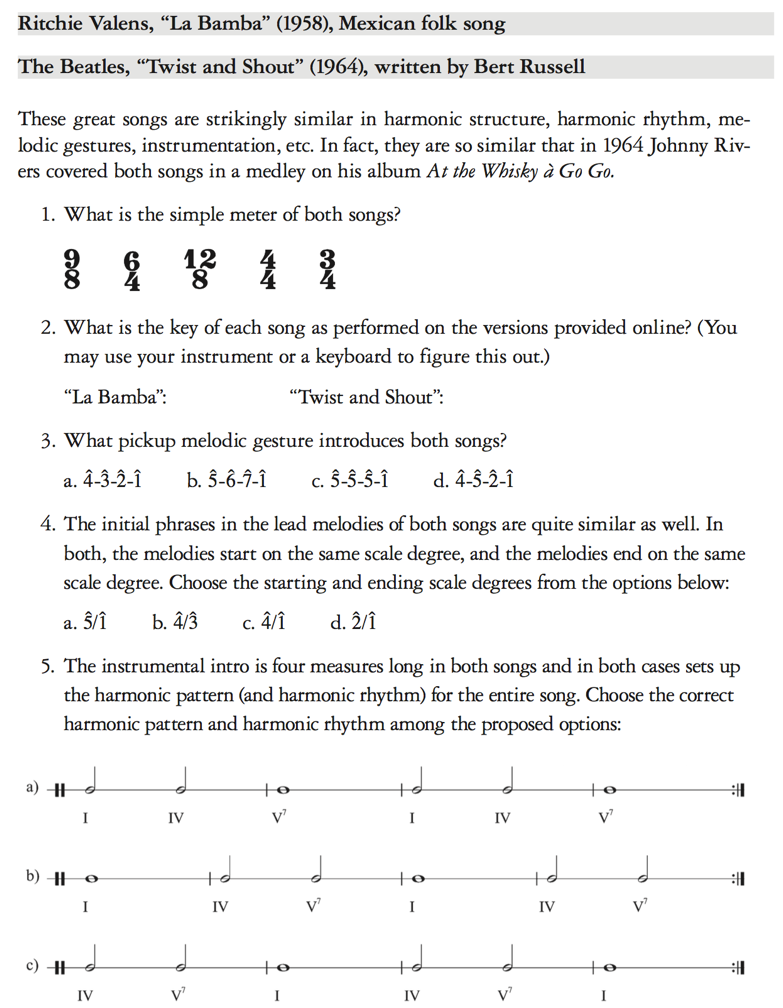
Finally, Jena Root's text Applied Music Fundamentals 9 (2013) incorporates a variety of musical styles and genres throughout; the slide shows a list of meter identification examples ranging from Bach and Bizet to Les Miserables and Carole King.
Example 5. Ch. 6, Jena Root, Applied Music Fundamentals: Writing, Singing, and Listening (2013), pp. 259-60 (Example used by permission of Oxford University Press, USA)
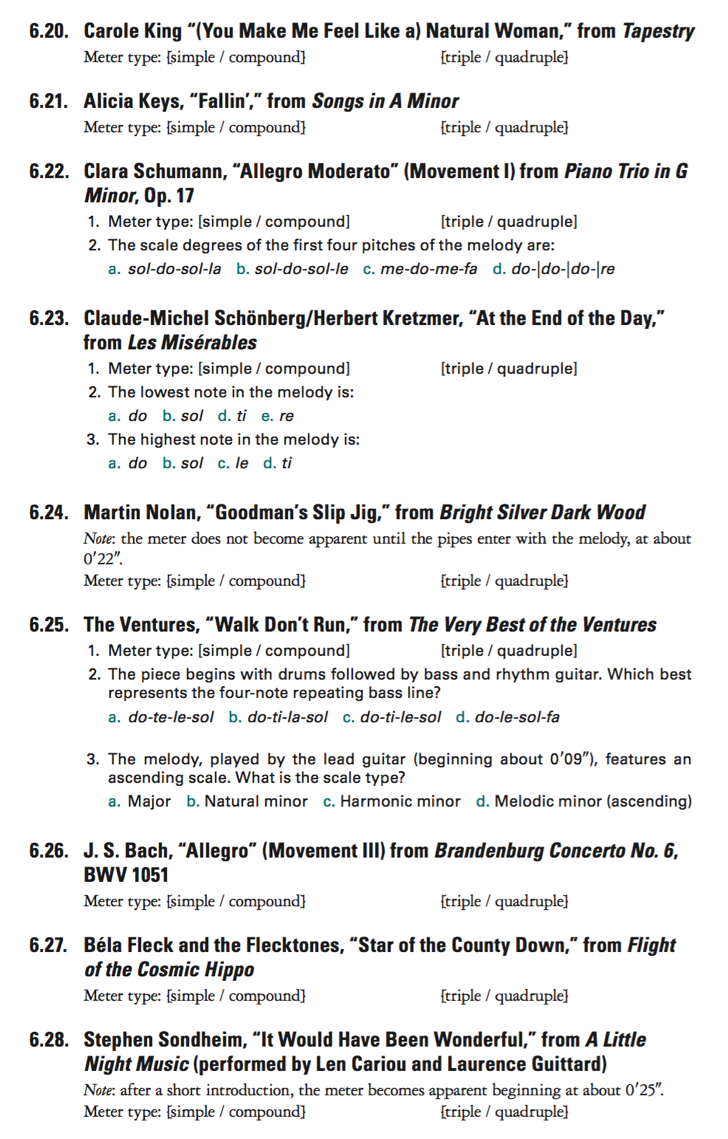
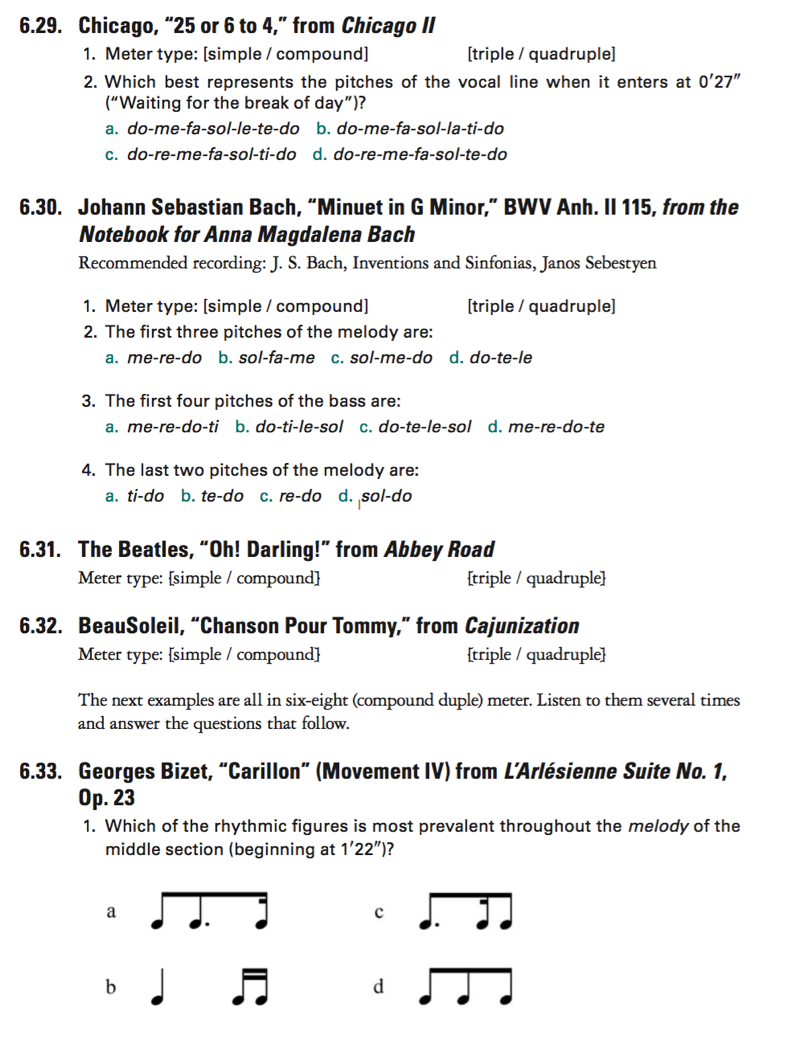
The growing diversity of teaching repertoire has also been demonstrated in the research literature on music theory pedagogy. In this vein, Nicole Biamonte's edited collection titled Pop-Culture Pedagogy in the Music Classroom: Teaching Tools from American Idol toYouTube (2011) deserves special mention. As the title suggests, this collection constitutes a group of essays devoted to using popular music in music teaching, and many of the essays focus on classroom music theory and aural skills teaching. Examples include James Hughes's essay "Using Pop-Culture Tools to Reinforce the Learning of Basic Music Theory as Transformations"; Heather MacLachlan's "Teaching Traditional Music Theory with Popular Songs: Pitch Structures," which includes an appendix with examples; and Nancy Rosenberg's essay on using pop music to teach rhythm and meter, which also includes appendices with resources and examples.10
The definition of diversity in the Manifesto does not include recently composed music, or music by women composers, which means that essays focusing on such music, like Deborah Rifkin's 2014 essay that promotes creativity through the analysis of texture and timbre in Jennifer Higdon's blue cathedral, are not included in the present bibliography, although I would argue that such articles exemplify both diversity and creativity.11
Creativity
The Manifesto limits the definition of creativity to improvisation and composition, and claims that "...the majority of music students graduate with little to no experience, let alone significant grounding, in the essential creative processes of improvisation and composition."12 Yet recently published textbooks and pedagogical literature nearly teem with such activities, and it appears that emphasis on composition and improvisation is only increasing. I will begin with some notable examples from textbook sources.
Aural Skills in Context, by Jones, Shaftel, and Chattah, features the word "improvisation" in its subtitle, and searching an electronic copy reveals that either "improvise" or "improvisation" appears on eighty-seven pages—and many of those pages feature multiple improvisational exercises. Example Six provides a page from Chapter 1, revealing that even very early in study, students are encouraged to demonstrate their understanding through spontaneous application of recently learned skills, and one sees as well that the improvisational activities continue on to the next page!
Example Six. Matthew R. Shaftel and Evan Jones with Juan Chattah, Aural Skills in Context: A Comprehensive Approach to Sight Singing, Ear Training, Keyboard Harmony, and Improvisation (2013), p. 45 (Example used by permission of Oxford University Press, USA)
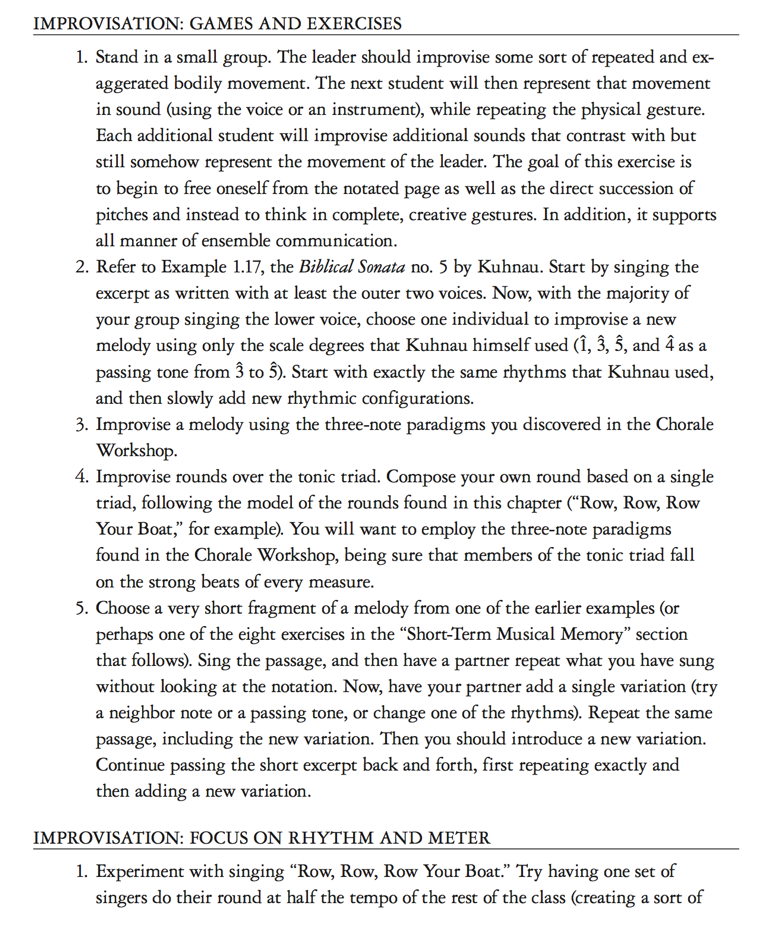
Phillips, Murphy, Clendinning, and Marvin's The Musician's Guide to Aural Skills includes frequent improvisation exercises, many of which incorporate keyboard; Example Seven, for instance, asks students to improvise vocally and instrumentally on progressions featuring predominant chords, and also encourages students to improvise in a number of styles and meters.
Example Seven. Phillips, Murphy, Marvin, Clendinning, The Musician's Guide to Aural Skills, 2nd ed. (2011), p. 393
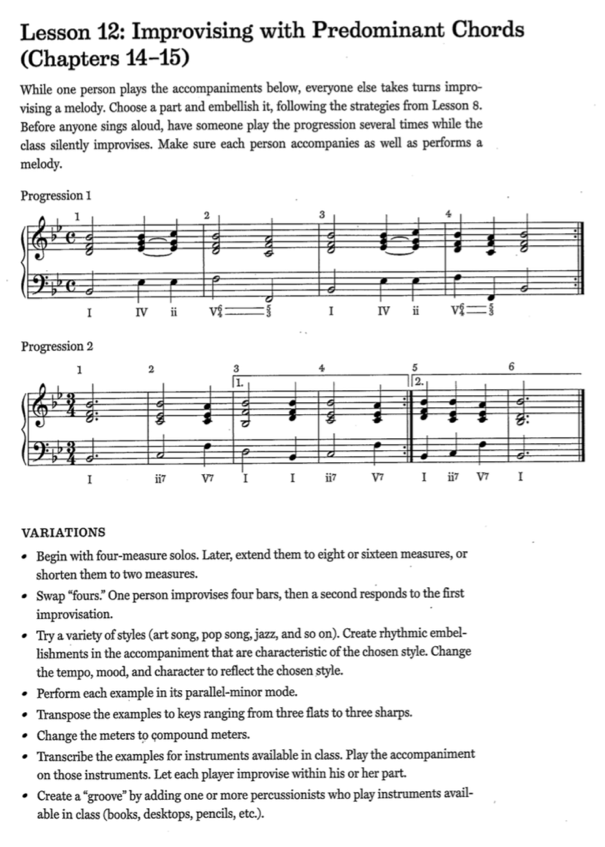
Jena Root's Applied Music Fundamentals provides students who are just beginning music theory study with ample opportunities to demonstrate the Manifesto's version of creativity. Example Eight shows a group improvisation exercise from Chapter 9; similar exercises are found throughout the book.
Example Eight. Root, Applied Music Fundamentals: Writing, Singing, and Listening (2013), p. 417 (Example used by permission of Oxford University Press, USA)
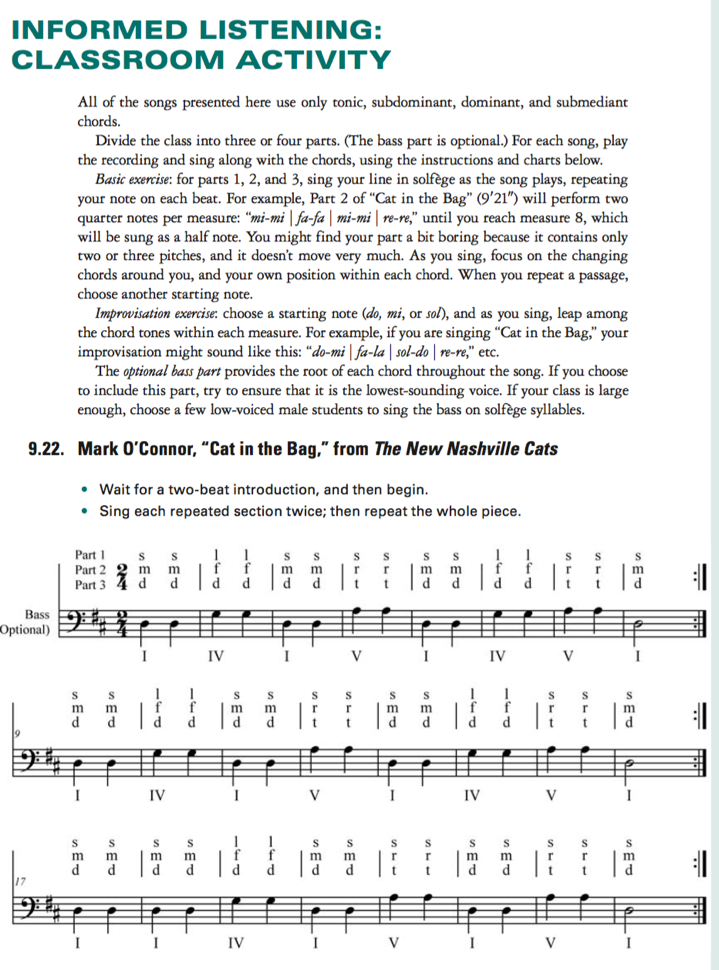
As is the case with textbooks, research in music theory pedagogy frequently deals with improvisation and composition. Some examples include Michael Callahan's work on incorporating keyboard improvisation into music theory study; 13 Nancy Rogers's transformation of the classic Minuet composition project into a project in which students instead compose a college fight song;14 Peter Schubert's article addressing the pedagogy of analysis through improvisation;15 and, of course, several recent articles that have focused on the use of recomposition in music analysis.16 And, last but certainly not least, all of the presentations at the Society for Music Theory's 2015 Music Improvisation Interest Group meeting were pedagogical in nature.17
Although many articles focusing on composition and improvisation have been published since the beginning of 2010 (twenty-six, to be exact), I feel obligated to call attention to the large number of articles that concentrate on how to elicit creativity from students through means other than composition and improvisation, or that focus on pedagogical creativity as a way to engage students. Such articles include Stanley V. Kleppinger's 2010 article offering a variety of ingenious approaches for captivating students with the process of beginning atonal analysis,18 as well as Matthew Bailey Shea's 2011 article offering a convincing methodology for encouraging students to construct meaningful narratives that are grounded in detailed analytical observations.19 Lest readers peruse my bibliography and think that only twenty-five articles on creativity in music theory pedagogy have been published in the last five years, I would argue that both articles just mentioned—along with many others!—have outlined innovative approaches to building students' capacities for creatively engaging with music, although the avenues they propose are alternative to composition and improvisation.
Current Trends in Pedagogical Research
In all, my bibliography lists forty-three published articles from 2010 to the present that focus on creativity, diversity, and integration (as they are defined in the Manifesto) in some central way. In order to determine what percentage of recent research in music theory pedagogy is focused upon one or more of the three pillars, I tallied the total number of articles published by the Journal of Music Theory Pedagogy since the beginning of 2010, and counted those that dealt in some central fashion with the three pillars of creativity, diversity, and integration (again, limiting my definitions of those concepts to those provided in the Manifesto). I found that 15 of 41 (37%, or over one-third) of articles published in the Journal of Music Theory Pedagogy from 2010-2014 substantially focused on at least one of the three pillars. Articles published in the Journal of Music Theory Pedagogy that did not substantially focus on Creativity, Diversity, and Integration as defined in the Manifesto were dedicated to focused topics appropriate to a publication intended for specialists, such as:
· Computer-aided instruction in music theory and aural skills pedagogy
· Cognition research and aural skills pedagogy
· "How-to" articles for introduction of specific concepts (for instance, the concept of inversional equivalence in set theory)
· General classroom teaching strategies applied to the music theory and aural skills classroom
· Application of recent music theoretical research to the classroom (for instance, the use of Hepokoski-Darcy's sonata theory in undergraduate instruction)
· Teaching students with disabilities
· Textbook reviews
In the interest of tracking whether research focusing on creativity, diversity, and integration has increased over time, I surveyed the contents of the Journal of Music Theory Pedagogy from the start of the year 2000 through 2004, and from the start of the year 2005 through 2009. I found that certain elements, such as the use of composition in music theory classes, have always been of interest in music theory pedagogy research, although the number and variety of articles on composition have increased in the last five years. Articles on other approaches, such as the inclusion of improvisation in music theory and aural skills classes, have risen sharply.
For example, from 2000-2004, the Journal of Music Theory Pedagogy published no articles on the use of improvisation in music theory and aural skills classes. From 2005-2009, only one article addressing the use of improvisation was published. Most recently, six articles on improvisation have appeared in the Journal of Music Theory Pedagogy from the beginning of 2010 through 2014.20 Perhaps most significantly, several of these articles bring up improvisation as a given; rather than being the central focus of the article, it is considered an implicit tool in the theory and aural skills teacher's arsenal. For instance, though improvisation is not the main focus of Deborah Rifkin and Philip Stoecker's 2011 article in the Journal of Music Theory Pedagogy, Example Nine shows thatimprovisation is included as a discrete step in their revision of Bloom's taxonomy, and improvisation is also included in sample lesson plans.21 I believe that this trend clearly articulates the extent to which improvisation is increasingly becoming part of the fabric of how many teachers of music theory approach their classrooms.
Example Nine. Deborah Rifkin and Philip Stoecker, "A Revised Taxonomy for Music Learning," Journal of Music Theory Pedagogy 25 (2011), p. 158 (Graphic used with author permission)
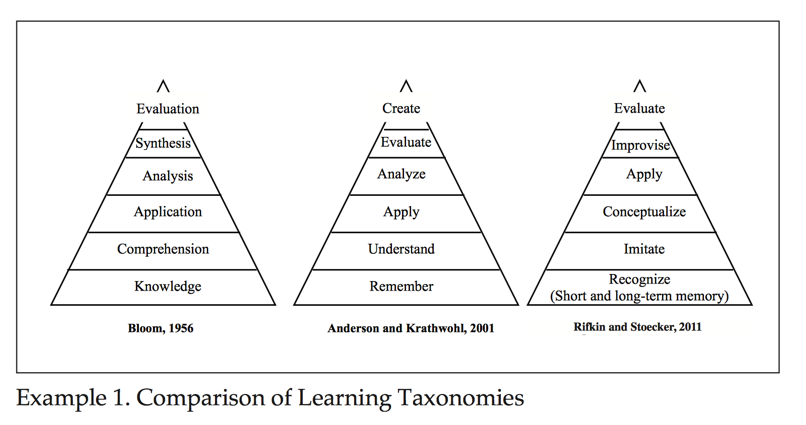
Conclusion
The wealth of published research in the field of music theory pedagogy that deals directly with integration, diversity, and creativity indicates that teachers of music theory are in fact focused on the three pillars outlined in the CMS Manifesto, and increasingly so. It would seem that the generalizations and claims made throughout the Manifesto do not reflect what is happening in the majority of our classrooms right now, at least not based on the reality reflected by current published textbooks and research in music theory pedagogy.
I will conclude my response with a quote from Peter Schubert's textbook on Modal Counterpoint, a subject that may sound dry only for those who have not experienced the joyful manner in which Schubert deals with the subject.22 He champions the importance of improvisation throughout the text on a historical and pedagogical basis, beginning in the introduction:
In the sixteenth century, boys learned to sight-sing and then to improvise counterpoint in the course of church services. Nowadays, although we think of counterpoint differently, primarily as a writing technique, there's a lot to be gained by trying to improvise within the rules. It's as fun, exciting, challenging, and satisfying as a fast-paced video game, and it's useful. It's the quickest way to learn to 'think in music' on your feet. If you improvise your homework, you'll be playing one line while singing another [...] an important exercise in basic musicianship.23
I elected to emphasize part of the foregoing passage as it made me cheer; this is exactly how I feel about improvisation myself, and it's how I feel about improvisation in pedagogy, too. It's also how many of my colleagues feel. And this sort of passion is why the broad, baseless claims leveled in the Manifesto invited an organized response: it is a gross misrepresentation of what is really in the hearts, minds, and, yes, classrooms of many teaching in the field of music theory in 2016. Are there, maybe, a few uninspiring folks who may reflect the straw theorist built, stuffed, and mounted in that document? Perhaps, but before such allegations are leveled against an entire field in the future, they ought to be corroborated with facts and research, rather than based on individual anecdotal perceptions.
From my view, it is nearly impossible to teach Mozart's style (and to explain why Baroque music became passé) in the context of an analysis class without discussing the ideals of the Enlightenment; it is nearly impossible to communicate meaningfully why certain constructions are avoided in species counterpoint without constantly asking students to sing their work—even though they think it sounds—and I quote—"awesome" when their music notation program plays it back at 700 beats per minute; it is nearly impossible to assess the depth of a student's understanding of phrase structure or melodic composition without asking them to improvise on a regular basis; it is nearly impossible to demonstrate the wide applicability of this material without showing students that the same harmonic sequence appears in the music of Beethoven, Rodgers and Hammerstein, TLC, and Aretha Franklin. All of this takes place in my classroom on a regular basis, and I know that I am not alone.
Notes
1Phillips, Murphy, Marvin, and Clendinning, The Musician's Guide to Aural Skills
2Laitz, Skills and Musicianship Workbook to Accompany The Complete Musician
3Rogers, Teaching Approaches in Music Theory, 14
4Callahan, "Teaching and Learning Undergraduate Music Theory at the Keyboard"
5Ng, "Recorded Performances as Text in the Music Theory Classroom"
6Salley, "On the Integration of Aural Skills and Formal Analysis through Popular Music"
7Snodgrass, Contemporary Musicianship: Analysis and the Artist
8Jones and Shaftel with Chattah, Aural Skills in Context
9Root, Applied Music Fundamentals
10All of the following essays were published in Pop-Culture Pedagogy in the Music Classroom: Teaching Tools from American Idol to YouTube. Scarecrow Press, edited by Nicole Biamonte (2011): Hughes, "Using Pop-Culture Tools to Reinforce the Learning of Basic Music Theory as Transformations," 95–108; MacLachlan, "Teaching Traditional Music Theory with Popular Songs: Pitch Structures," 73–94; and Rosenberg, "Popular Music in the College Music Theory Class: Rhythm and Meter," p. 47–72.
11Rifkin, "Cultivating Creativity in the Music Theory Classroom"
12 "Transforming Music Study from its Foundations," 17
13Callahan, "Teaching and Learning Undergraduate Music Theory at the Keyboard"
14Rogers, "Modernizing the Minuet Composition Project"
15Schubert, "Teaching Music Analysis through Improvisation," Engaging Students: Essays in Music Pedagogy 2 (2014), http://flipcamp.org/engagingstudents2/essays/schubert.html, accessed September 23, 2015.
16See Aziz, "Recomposition and the Sonata Theory Learning Laboratory"; Hoag, "Hearing 'What Might Have Been': Using Recomposition to Foster Music Appreciation in the Theory Classroom"; Johnson, "Recomposition as Low-Stakes Analysis"; Stevens, "Breaking (Musical) Stuff as an Act of (Music) Criticism"; Stevens, "Inverting Analysis."
17Topics presented at SMT's 2015 Music Improvisation Interest Group meeting included: Taylor Carmona(University of Missouri Kansas City), "Melodic Conventions Through Improvisation"; Scott Murphy (University of Kansas), "Impromptu Discernment of Canonic Potential"; Nancy Rogers (Florida State University), "Leading by the Ear: Improvising Harmony in the Music Theory Classroom"; Johnandrew Slonimski and Gilad Rabinovitch (Eastman School of Music), "Partimenti and Galant Schemata: Historical and Modern Tools for Teaching Improvisation"; and Ji Hyn Woo (SUNY Fredonia), "Having Fun Clapping and Singing, While Improvising a Modal Tune."
18Kleppinger, "Strategies for Introducing Pitch-Class Set Theory in the Undergraduate Classroom"
19BaileyShea, "Teaching Agency and Narrative Analysis: The Chopin Preludes in E Minor and E Major"
20These six recent articles on improvisation have included: Callahan, "Teaching Baroque Counterpoint Through Improvisation: An Introductory Curriculum in Stylistic Fluency"; Gross, "The Improvisation of Figuration Preludes and the Enduring Value of Bach Family Pedagogy"; Porter, "Why is Improvisation So Difficult?"; Rifkin and Stoecker, "A Revised Taxonomy for Music Learning"; Ristow,Thomsen, and Urista, "Dalcroze's Approach to Solfège and Ear Training for the Undergraduate Aural Skills Curriculum"; Schubert, "Global Perspective on Music Theory Pedagogy: Thinking in Music."
21Rifkin and Stoecker, 158
22Schubert, Modal Counterpoint. Also, Schubert's instructional videos on how to improvise a canon in the Renaissance style are inspiring, empowering, and informative. See, for example: https://www.youtube.com/watch?v=n01J393WpKk, accessed January 10, 2016.
23Ibid, xii.
Appendix: Integration, Diversity, Creativity
A Bibliography of music theory pedagogy articles published since the beginning of 2010 that include a substantial focus on Integration, Diversity, Creativity
Sources: all music theory pedagogy journals, plus the College Music Symposium, as well as relevant edited collections of essays
Articles focusing on Integration
Auerbach, Brent. "Pedagogical Applications of the Video Game Dance Dance Revolution to Aural Skills Instruction." Music Theory Online 16/1 (2010). http://www.mtosmt.org/issues/mto.10.16.1/mto.10.16.1.auerbach.html. Accessed September 10, 2015.
Bannan, Nicholas. "Embodied Music Theory: New Pedagogy for Creative and Aural Development." Journal of Music Theory Pedagogy 24 (2010): 197–216.
Callahan, Michael. "Teaching and Learning Undergraduate Music Theory at the Keyboard: Challenges, Solutions, and Impacts." Music Theory Online 21/3 (2015). http://www.mtosmt.org/issues/mto.15.21.3/mto.15.21.3.callahan.html. Accessed October 5, 2015.
Check, John. "Back to School: A Report on the Institute for Music Theory Pedagogy." Journal of Music Theory Pedagogy 28 (2014): 59–66. Report describes presentations that addressed integration:
- "Intersections Between Analysis and Performance" (Brian Alegant)
- "Linking Aural Skills Teaching to Perception and Performance" (Ted Goldman)
- "Bringing it all Together: Model Composition" (Steve Laitz)
Hoag, Melissa."Seven strategies for enabling student success in the first-year music theory sequence." Music Theory Pedagogy-Online 1 (2013).
Ng, Samuel. "Recorded Performances as Text in the Music Theory Classroom." Journal of Music Theory Pedagogy 28 (2014): 87–119.
Oravitz, Michael. "The Use of Caplin/Schoenberg Thematic Prototypes in Melodic Dictations." Journal of Music Theory Pedagogy 26 (2012): 101–38.
Porter, William. "Why is Improvisation So Difficult?" Journal of Music Theory Pedagogy 27 (2013): 7–18.
Salley, Keith. "On the Integration of Aural Skills and Formal Analysis through Popular Music." In Nicole Biamonte, ed., Pop-Culture Pedagogy in the Music Classroom: Teaching Tools from American Idol to YouTube. Scarecrow Press, 2011: 109–132.
Schubert, Peter."My Undergraduate Skills-Intensive Counterpoint Learning Environment (MUSICLE)." Engaging Students: Essays in Music Pedagogy 1 (2013). http://www.flipcamp.org/engagingstudents/. Accessed October 5, 2015.
Stevens, Daniel B. "Breaking (Musical) Stuff as an Act of (Music) Criticism." Engaging Students: Essays in Music Pedagogy 3 (2015). http://flipcamp.org/engagingstudents3/essays/stevens1.html. Accessed September 23, 2015.
Articles focusing on Diversity
Auerbach, Brent. "Pedagogical Applications of the Video Game Dance Dance Revolution to Aural Skills Instruction." Music Theory Online 16/1 (2010). http://www.mtosmt.org/issues/mto.10.16.1/mto.10.16.1.auerbach.html. Accessed September 10, 2015.
______, Brett Aarden, and Mathonwy Bostock. "DDR at the Crossroads: A Report on a Pilot Study to Integrate Music Video-Game Technology into the Aural-Skills Classroom." In Nicole Biamonte, ed., Pop-Culture Pedagogy in the Music Classroom: Teaching Tools from American Idol to YouTube. Scarecrow Press, 2011: 149–72.
Biamonte, Nicole. "Musical Representation in the Video Games Guitar Hero and Rock Band." In Nicole Biamonte, ed., Pop-Culture Pedagogy in the Music Classroom: Teaching Tools from American Idol to YouTube. Scarecrow Press, 2011: 133–48.
Check, John. "Back to School: A Report on the Institute for Music Theory Pedagogy." Journal of Music Theory Pedagogy 28 (2014): 59–66.
Report includes the following presentation, which addressed diversity in the theory classroom:
- "Pop Music in the Theory Classroom" (John Covach)
de Clerq, Trevor. "Grooves, Drones, and Loops: Enhancing Aural Skills Exercises with Rock Music Contexts." Engaging Students: Essays in Music Pedagogy 2 (2014). http://flipcamp.org/engagingstudents2/essays/declercq.html. Accessed September 23, 2015.
Hoag, Melissa. "Hearing 'What Might Have Been': Using Recomposition to Foster Music Appreciation in the Theory Classroom." Journal of Music Theory Pedagogy 27 (2013): 47–69.
______. "Seven strategies for enabling student success in the first-year music theory sequence." Music Theory Pedagogy-Online 1 (2013).
Hughes, James R. "Using Pop-Culture Tools to Reinforce the Learning of Basic Music Theory as Transformations." In Nicole Biamonte, ed., Pop-Culture Pedagogy in the Music Classroom: Teaching Tools from American Idol to YouTube. Scarecrow Press, 2011: 95–108.
Julien, Patricia. "How to Write a Jazz Composition's Chord Progression." Journal of Music Theory Pedagogy 26 (2012): 29–58.
Kulma, Dave, and Meghan Naxer. "Beyond Part Writing: Modernizing the Curriculum." Engaging Students: Essays in Music Pedagogy 2 (2014).
http://flipcamp.org/engagingstudents2/essays/kulmaNaxer.html. Accessed September 23, 2015.
MacLachlan, Heather. "Teaching Traditional Music Theory with Popular Songs: Pitch Structures." Includes appendix with examples. In Nicole Biamonte, ed., Pop-Culture Pedagogy in the Music Classroom: Teaching Tools from American Idol to YouTube. Scarecrow Press, 2011: 73–94.
Malawey, Victoria. "An Analytic Model for Examining Cover Songs and Their Sources." In Nicole Biamonte, ed., Pop-Culture Pedagogy in the Music Classroom: Teaching Tools from American Idol to YouTube. Scarecrow Press, 2011: 203–32.
Musso, Paul. "Utilizing The Tone Row in Jazz Pedagogy: A Technique to Create Tonal Harmony in an Atonal Environment." Music Theory Pedagogy-Online 3 (2014).
Rogers, Nancy. "Modernizing the Minuet Composition Project." Journal of Music Theory Pedagogy 27 (2013): 71–110.
Rosenberg, Nancy. "Bach, Beck, and Björk Walk into a Bar: Reclassifying Harmonic Progressions to Accommodate Popular Music Repertoire in the Traditional Music Theory Class." Journal of Music Theory Pedagogy 28 (2014): 163–209.
______. "Popular Music in the College Music Theory Class: Rhythm and Meter." Includes appendices with resources and examples. In Nicole Biamonte, ed., Pop-Culture Pedagogy in the Music Classroom: Teaching Tools from American Idol to YouTube. Scarecrow Press, 2011: 47–72.
Salley, Keith. "On the Integration of Aural Skills and Formal Analysis through Popular Music." In Nicole Biamonte, ed., Pop-Culture Pedagogy in the Music Classroom: Teaching Tools from American Idol to YouTube. Scarecrow Press, 2011: 109–132.
Articles focusing on Creativity (Composition (C) or Improvisation (I))
Aziz, Andrew. "Recomposition and the Sonata Theory Learning Laboratory." Journal of Music Theory Pedagogy-Online 5 (2015). http://music.appstate.edu/node/3414. Accessed January 10, 2016. C
Callahan, Michael. "Improvising Motives: Applications of Michael Wiedeburg's Pedagogy of Modular Diminutions." Intégral 24 (2010): 29-56. I, C
______. "Teaching and Learning Undergraduate Music Theory at the Keyboard: Challenges, Solutions, and Impacts." Music Theory Online 21/3 (2015). http://www.mtosmt.org/issues/mto.15.21.3/mto.15.21.3.callahan.html. Accessed October 5, 2015. I
______. "Teaching Baroque Counterpoint Through Improvisation: An Introductory Curriculum in Stylistic Fluency." Journal of Music Theory Pedagogy 26 (2012): 61–99. I
Check, John. "Back to School: A Report on the Institute for Music Theory Pedagogy." Journal of Music Theory Pedagogy 28 (2014): 59–66.
Report describes presentations at the institute on such varied topics as:
- "Bringing it all Together: Model Composition" (Steve Laitz) C
- "Tonal Improvisation in the Undergraduate Curriculum" (Steve Laitz). I
Gross, Austin. "The Improvisation of Figuration Preludes and the Enduring Value of Bach Family Pedagogy." Journal of Music Theory Pedagogy 27 (2013): 19–45. I
Hoag, Melissa. "Hearing 'What Might Have Been': Using Recomposition to Foster Music Appreciation in the Theory Classroom." Journal of Music Theory Pedagogy 27 (2013): 47–69. C
______. "Seven strategies for enabling student success in the first-year music theory sequence." Music Theory Pedagogy-Online 1 (2013). C
Johnson, Vicky. "Proficiency-Based Learning with Muscle in a Music Theory Classroom." Engaging Students: Essays in Music Pedagogy 3 (2015). C http://flipcamp.org/engagingstudents3/essays/johnson.html. Accessed September 24, 2015.
Johnson, Shersten. "Recomposition as Low-Stakes Analysis." Engaging Students: Essays in Music Pedagogy 2 (2014). C http://flipcamp.org/engagingstudents2/essays/johnson.html. Accessed September 23, 2015.
Julien, Patricia. "How to Write a Jazz Composition's Chord Progression." Journal of Music Theory Pedagogy 26 (2012): 29–58. C
Lodewyckx, David, and Pieter Bergé. "Partimento, Waer bestu bleven? Partimento in the European Classroom: Pedagogical Considerations and Perspectives." Music Theory and Analysis 1/1-2 (2014): 146–69. C
Michaelsen, Garrett. "Improvising to Learn/Learning to Improvise: Designing Scaffolded Group Improvisations for the Music Theory Classroom." Engaging Students: Essays in Music Pedagogy 2 (2014). I http://flipcamp.org/engagingstudents2/essays/michaelsen.html. Accessed September 23, 2015.
Palmer, Michael C. "Learning Basic Music Theory through Improvisation: Implications for Including Improvisation in the University Curriculum." College Music Symposium 54 (2014). I http://symposium.music.org/index.php?option=com_k2&view=item&id=10844:learning-basic-music-theory-through-improvisation-implications-for-including-improvisation-in-the-university-curriculum. Accessed October 5, 2015.
Porter, William. "Why is Improvisation So Difficult?" Journal of Music Theory Pedagogy 27 (2013): 7–18. I
Rabinovitch, Gilad and Johnandrew Slominski. "Towards a Galant Pedagogy: Partimenti and Schemata as Tools in the Pedagogy of Eighteenth-Century Style Improvisation." Music Theory Online 21/3 (2015). I
Rifkin, Deborah, and Philip Stoecker. "A Revised Taxonomy for Music Learning." Journal of Music Theory Pedagogy 25 (2011): 155–89. I
Ristow, Gregory, Kathy Thomsen, and Diane Urista. "Dalcroze's Approach to Solfège and Ear Training for the Undergraduate Aural Skills Curriculum."Journal of Music Theory Pedagogy 28 (2014): 121–60. I
Rogers, Nancy. "Modernizing the Minuet Composition Project." Journal of Music Theory Pedagogy 27 (2013): 71–110. C
Schubert, Peter. "Global Perspective on Music Theory Pedagogy: Thinking in Music." Journal of Music Theory Pedagogy 25 (2011): 217–34. C, I
______."My Undergraduate Skills-Intensive Counterpoint Learning Environment (MUSICLE)." Engaging Students: Essays in Music Pedagogy 1 (2013). C, I http://www.flipcamp.org/engagingstudents/. Accessed October 5, 2015.
______. "Peter Schubert: YouTube" [YouTube channel featuring instructional videos on improvisation of Renaissance canons]. I https://www.youtube.com/channel/UCPdwE21gqS7voKPI2GDs_-A. Accessed October 5, 2015.
______. "Teaching Music Analysis through Improvisation." Engaging Students: Essays in Music Pedagogy 2 (2014). I http://flipcamp.org/engagingstudents2/essays/schubert.html. Accessed September 23, 2015.
Silbermann, Peter. "Teaching Classic Era Style Through Keyboard Accompaniment." Journal of Music Theory Pedagogy 26 (2012): 141–89. C
Stevens, Daniel B. "Breaking (Musical) Stuff as an Act of (Music) Criticism." Engaging Students: Essays in Music Pedagogy 3 (2015). C http://flipcamp.org/engagingstudents3/essays/stevens1.html. Accessed September 23, 2015.
______. "Inverting Analysis." Engaging Students: Essays in Music Pedagogy 3 (2015). C http://flipcamp.org/engagingstudents3/essays/stevens2.html. Accessed September 23, 2015.
Textbooks that address one or more of the three pillars
Carr, Maureen, and Bruce Benward, with Taylor Greer, Eric McKee, and Phillip Torbert. Sight Singing Complete. 8th ed. McGraw Hill Education, 2015.
Jones, Evan, and Matthew Shaftel, with Juan Chattah. Aural Skills in Context: A Comprehensive Approach to Sight Singing, Ear Training, Keyboard Harmony, and Improvisation. Oxford University Press, 2013.
Laitz, Steven G. Skills and Musicianship Workbook to Accompany The Complete Musician. 3rd ed. Oxford University Press, 2012.
Philips, Joel, Paul Murphy, Elizabeth West Marvin, and Jane Piper Clendinning. The Musician's Guide to Aural Skills. 2nd ed. W. W. Norton & Company, 2011.
Rogers, Nancy, and Robert W. Ottman. Music for Sight Singing. 9th ed. Pearson, 2013.
Root, Jena. Applied Music Fundamentals. Oxford University Press, 2013.
Schubert, Peter. Modal Counterpoint. Second Edition. Oxford University Press, 2007.
Snodgrass, Jennifer S. Contemporary Musicianship: Analysis and the Artist. Oxford University Press, 2015.
Bibliography
Aziz, Andrew. "Recomposition and the Sonata Theory Learning Laboratory." Journal of Music Theory Pedagogy-Online 5 (2015). http://music.appstate.edu/node/3414. Accessed January 10, 2016.
BaileyShea, Matthew. "Teaching Agency and Narrative Analysis: The Chopin Preludes in E Minor and E Major." Journal of Music Theory Pedagogy 25 (2011): 9–38.
Callahan, Michael R. "Teaching and Learning Undergraduate Music Theory at the Keyboard: Challenges, Solutions, and Impacts," Music Theory Online 21/3 (2015). http://www.mtosmt.org/issues/mto.15.21.3/mto.15.21.3.callahan.html. Accessed November 30, 2015.
______. "Teaching Baroque Counterpoint Through Improvisation: An Introductory Curriculum in Stylistic Fluency." Journal of Music Theory Pedagogy 26 (2012): 61–99.
Gross, Austin. "The Improvisation of Figuration Preludes and the Enduring Value of Bach Family Pedagogy." Journal of Music Theory Pedagogy 27 (2013): 19–45.
Hoag, Melissa. "Hearing 'What Might Have Been': Using Recomposition to Foster Music Appreciation in the Theory Classroom." Journal of Music Theory Pedagogy 27 (2013): 47–69.
Hughes, James. "Using Pop-Culture Tools to Reinforce the Learning of Basic Music Theory as Transformations." In Pop-Culture Pedagogy in the Music Classroom: Teaching Tools from American Idol to YouTube, edited by Nicole Biamonte, 95–108. Lanham, MD: Scarecrow Press, 2011.
Johnson, Shersten. "Recomposition as Low-Stakes Analysis." Engaging Students: Essays in Music Pedagogy 2 (2014). http://flipcamp.org/engagingstudents2/essays/johnson.html. Accessed September 23, 2015.
Kleppinger, Stanley V. "Strategies for Introducing Pitch-Class Set Theory in the Undergraduate Classroom." Journal of Music Theory Pedagogy 24 (2010): 131–56.
Laitz, Steven G. Skills and Musicianship Workbook to Accompany The Complete Musician. 3rd ed. Oxford: Oxford University Press, 2011.
MacLachlan, Heather. "Teaching Traditional Music Theory with Popular Songs: Pitch Structures." In Pop-Culture Pedagogy in the Music Classroom: Teaching Tools from American Idol to YouTube, edited by Nicole Biamonte, 73–94. Lanham, MD: Scarecrow Press, 2011.
Marvin, Elizabeth West. "The Core Curricula in Music Theory-Development and Pedagogical Trends." Journal of Music Theory Pedagogy 26 (2012): 255-263.
Ng, Samuel. "Recorded Performances as Text in the Music Theory Classroom." Journal of Music Theory Pedagogy 28 (2014): 87–119.
Phillips, Joel, Paul Murphy, Elizabeth West Marvin, and Jane Piper Clendinning. The Musician's Guide to Aural Skills. 2nd ed. New York: W.W. Norton & Company, 2011.
Porter, William. "Why is Improvisation So Difficult?" Journal of Music Theory Pedagogy 27 (2013): 7–18.
Rifkin, Deborah. "Cultivating Creativity in the Music Theory Classroom: Telling Tales with Texture and Timbre." Engaging Students: Essays in Music Pedagogy 2 (2014). http://flipcamp.org/engagingstudents2/essays/rifkin.html. Accessed January 10, 2016.
______, and Philip Stoecker. "A Revised Taxonomy for Music Learning." Journal of Music Theory Pedagogy 25 (2011): 155–89.
Ristow,Gregory, Kathy Thomsen, and Diane Urista. "Dalcroze's Approach to Solfège and Ear Training for the Undergraduate Aural Skills Curriculum." Journal of Music Theory Pedagogy 28 (2014): 121–160.
Rogers, Michael. Teaching Approaches in Music Theory: An Overview of Pedagogical Philosophies. Carbondale: Southern Illinois University Press, 2004.
Rogers, Nancy. "Modernizing the Minuet Composition Project." Journal of Music Theory Pedagogy 27 (2013): 71–110.
Root, Jena. Applied Music Fundamentals. Oxford: Oxford University Press, 2013.
Rosenberg, Nancy. "Popular Music in the College Music Theory Class: Rhythm and Meter." In Pop-Culture Pedagogy in the Music Classroom: Teaching Tools from American Idol to YouTube, edited by Nicole Biamonte, 47–72. Lanham, MD: Scarecrow Press, 2011.
Salley, Keith. "On the Integration of Aural Skills and Formal Analysis through Popular Music." In Pop-Culture Pedagogy in the Music Classroom: Teaching Tools from American Idol to YouTube, edited by Nicole Biamonte, 109–32. Lanham, MD: Scarecrow Press, 2011.
Schubert, Peter. "Global Perspective on Music Theory Pedagogy: Thinking in Music." Journal of Music Theory Pedagogy 25 (2011): 217–34.
______. "Peter Schubert: YouTube" [YouTube channel featuring instructional videos on improvisation of Renaissance canons]. https://www.youtube.com/channel/UCPdwE21gqS7voKPI2GDs_-A. Accessed October 5, 2015.
______. Modal Counterpoint: Renaissance Style. Oxford: Oxford University Press, 2007.
______. "Teaching Music Analysis through Improvisation." Engaging Students: Essays in Music Pedagogy 2 (2014). http://flipcamp.org/engagingstudents2/essays/schubert.html. Accessed September 23, 2015.
Snodgrass, Jennifer. Contemporary Musicianship: Analysis and the Artist. Oxford: Oxford University Press, 2015.
Stevens, Daniel B. "Breaking (Musical) Stuff as an Act of (Music) Criticism." Engaging Students: Essays in Music Pedagogy 3 (2015). http://flipcamp.org/engagingstudents3/essays/stevens1.html. Accessed September 23, 2015
______. "Inverting Analysis." Engaging Students: Essays in Music Pedagogy 3 (2015).http://flipcamp.org/engagingstudents3/essays/stevens2.html. Accessed September 23, 2015.
"Transforming Music Study from its Foundations," College Music Society website, http://www.music.org/pdf/tfumm_report.pdf, 17. Accessed January 10, 2016.


